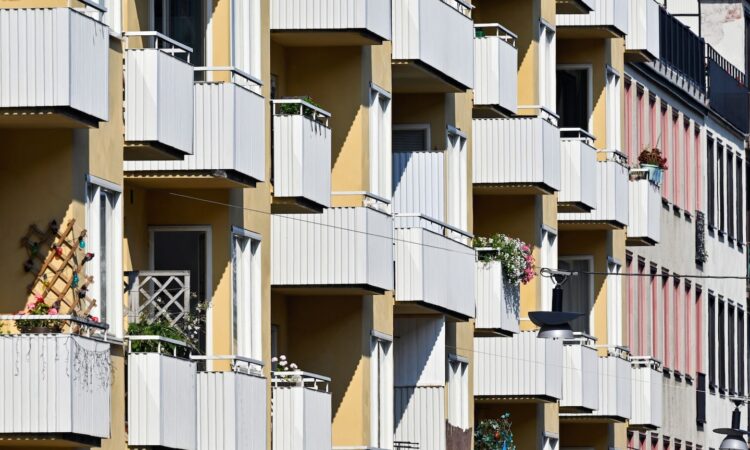
1. Why did the market rise so sharply?
There had been warnings, for years if not decades, of an exaggerated run-up in housing prices. Home values were driven up by a shortage of housing, years of low interest rates and by mortgages that for years required only interest payments. New amortization requirements introduced from 2016 changed that, but most households are still only obliged to pay down their debt to 50% of property values. The results include home-price increases that outstripped the pace of wage hikes as well as gross domestic product expansion, and left many home owners deep in debt.
2. What caused the fall?
Around the world, housing markets suffered in 2022 as central banks raised interest rates in response to sharp increases in inflation. But the fallout in Sweden was particularly dramatic, in large part because the prevalence of floating-rate mortgages has left households there unusually vulnerable to interest-rate changes. More than 40% of mortgages reset their rates in three months or less, and only 18% are fixed for terms of three years or more. And Swedish household debt in 2022 was on average 200% of annual disposable income, up from 150% 15 years ago. That seemed easier to sustain during the unprecedented 7½-year period during which the Riksbank set rates at zero or below. That ended in April, when it began to raise rates. By the end of the year, the central bank had taken its benchmark rate to 2.5% and expected to continue hiking in 2023.
3. What is the global context?
The development in the Swedish housing market is just one example of a reckoning that is unfolding as the world emerges from an era of cheap credit, which has led to ballooning debt. In 2022, housing prices declined in countries including Canada, Australia and China, and forecasters warn of an impending slump in the UK. But just as its price gains exceeded most European markets since the 2008 financial crisis, Sweden is taking a harder hit now that trends are reversing.
The main concern, for now, is that households will slash spending as dropping home values make them feel poorer — just as real wages, that is, wage adjusted for an inflation rate of close to 10%, are dropping at a record pace. The transmission of rate hikes to mortgage rates is expected to have a rapid effect on consumers’ finances. The central bank still believes the fallout can be limited to a mild recession in 2023, while other forecasters, such as Nordea Bank Abp chief economist Annika Winsth, have warned that the Riksbank may be underestimating the impact. The bank, which is the Nordic region’s largest, stressed that falling home prices typically make households tighten purse strings as the lender downgraded its forecasts to indicate that the Swedish economy will shrink by 2% this year.
Forecasters have converged around calls for a 20% decline from the peak, but it could get worse. Their projections are based on the assumption that unemployment won’t surge and that the Riksbank will stay its hand once its key interest rate reaches about 3%. Neither is guaranteed. With consumer confidence near all-time lows, the hitherto stable situation in the labor market could shift drastically next year. The central bank has warned that should inflation refuse to budge, it may have to take its benchmark rate above 4.5%. In such a scenario, and with the added risk that electricity prices remain at record levels as the effect of Russia’s curbs on energy exports continued to ripple throughout Europe, it is hard to see the decline in home prices stalling at 20%.
6. Is it all bleak, then?
Well, there are a few factors that might give some comfort. Speculative buying has been limited by restrictions on subletting, and a shortage of housing should provide a cushion in many local markets. Also, real-estate agents — admittedly perpetual optimists — report that there has been some stabilization in Stockholm, which is sometimes seen as a bellwether for the broader market. Most forecasters still believe that prices will continue falling until there are signs that inflation is moderating, which would bring some clarity on how high interest rates will go.
7. Is there a risk that this will set off a financial crisis?
It seems unlikely. The country’s financial supervisory authority still expects most new mortgage takers to have sufficient margins for servicing their loans, even if their finances weaken. Some households may find themselves in trouble but as of yet there is little concern that such problems will translate into significant credit losses in the banking system. Borrowers are stress-tested by lenders and Sweden’s generous social welfare system provides support through unemployment and illness. For those who still have trouble paying their interest-rate costs, there is no way of getting rid of a mortgage by foreclosure. The latest stress test by the Swedish financial watchdog showed that in a scenario where housing prices continue plunging for three years and unemployment increases significantly, banks’ mortgage-credit losses would amount to less than 1% of outstanding stock. Hence, authorities are more concerned about credit losses and contagion effects from Sweden’s commercial real-estate sector than from housing.
–With assistance from Ott Ummelas.
More stories like this are available on bloomberg.com






